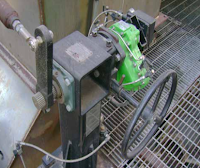 |
| Infrared moisture analyzer (courtesy of Chino America) |
IR moisture analyzers shine light onto the product as it passes along via conveyor belt. The instrument measures the light being reflected back by the sample. Since the moisture in the product will absorb some of the IR light, fewer of those particular wavelengths are reflected back to the measurement sensor in the instrument. By determining the amount of light absorbed you can calculate the amount of moisture in the product.
 |
| Moisture detection diagram for wheat flour process (courtesy of Chino America) |
The analyzers used in the wheat flour application measure from 5 to 15% moisture (with a ±0.2% accuracy) in the flour during the final processing before its packed into bags. By using this IR analyzer, maintaining very consistent quality and avoiding too much moisture in the product is possible.
 |
| Chino Infrared Moisture Analyzer |
Additionally, production costs were lowered because of more efficient control of its drying process. To prevent over-drying, a cascade control scheme was adopted, where the signals from moisture gauge combined with temperature measurement are used to control temperature of the drier.
For more information on Infrared moisture analyzers, contact:
Power Specialties, Inc.
9118 E. 72nd Terrace
Raytown, MO 64133
Toll Free: (800) 432-6550
Phone: (816) 353-6550
Fax: (816) 353-1740





